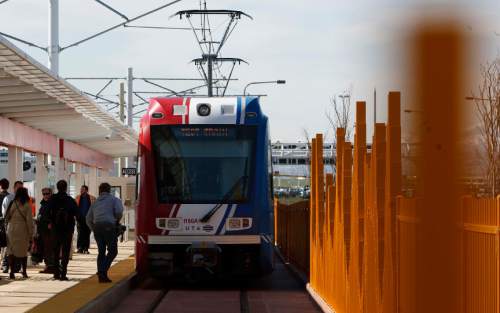This is an archived article that was published on sltrib.com in 2015, and information in the article may be outdated. It is provided only for personal research purposes and may not be reprinted.
Over the past year, the Utah Transit Authority has been in the headlines with criticism about high pay, big bonuses, extensive executive travel and alleged sweetheart deals with developers, among other controversies.
But the agency says newly released polling that it commissioned shows the public still gives it a 74 percent positive approval rating.
"Running a multi-modal transit system efficiently and reliably poses many challenges, but the annual survey shows that the majority of the people up and down the Wasatch Front are pleased with the service UTA provides and its role in the community," said UTA spokesman Remi Barron.
Polling and focus groups, costing about $33,650, were conducted in December by Dan Jones & Associates for UTA. It interviewed 601 people, and its findings have a margin of error of plus or minus 4 percent, Barron said.
He adds that UTA does such polling every year "to gauge public opinion and what people want from their transit agency."
The survey — presented to UTA Board members this week — asked, "Overall, do you have a favorable or unfavorable impression of the Utah Transit Authority?"
Seventy-four percent said they had favorable views, 13 percent had unfavorable impressions and others were neutral or undecided.
That is significant because a just-passed law allows the UTA, cities and counties jointly to ask voters soon for a sales-tax hike of a quarter-cent per $1 in sales to improve transportation. If passed, 40 percent of the new revenue would go to UTA, 40 percent to cities and 20 percent to counties.
The survey also asked, "Considering the ways public transit has changed over the past several years, are you satisfied or dissatisfied with the direction public transit is going?"Eighty percent were somewhat or very satisfied, 18 percent were dissatisfied and others were unsure.
When people were asked if they agreed with the statement, "UTA makes good use of public funds," 54 percent agreed, 19 percent disagreed and others were neutral or unsure.
Also, 78 percent of respondents reported favorable impressions of TRAX, 75 percent thought favorably about FrontRunner commuter trains, and 50 percent had favorable feelings about bus service.
The survey found that 94 percent of respondents have cars or other transportation available to them other than UTA transit.
Pollsters also asked people what would persuade them to ride public transit more often.
The highest item on that list would be to add more routes or coverage by transit. On a scale of one to seven, with seven being the most important, that option rated an average response of 5.35.
Next highest was having more frequent service, receiving a 5.22 on the scale of one to seven.
Behind that was escaping traffic congestion, 4.92; avoiding high gasoline prices, 4.54; and helping reduce pollution on poor air-quality days, 4.26.
Barron said findings will be used "in an effort to better meet the needs of our customers."
Christopher Stout, president of the Utah Transit Riders Union, a group that pushes for increased bus service, says the results show people are less than thrilled with current levels of bus service.
"The No. 1 and No. 2 issues to improve [ridership, according to the survey] are more routes and service, which is what we have been saying," he said, noting that UTA reduced bus service, especially at night and on weekends, during the recession to help pay for new rail projects.
Stout said the relatively low approval rating of bus service — with 50 percent approval — shows "that really is their Achilles' heel. They have got to get buses back on the roads, back in the neighborhoods and they have got to run them later at night."
He added, "When it comes down to it, the types of people who really need to be using mass transit can't because of no bus service nearby, no routes, no late-night service… They [UTA officials] have just got to get their act together."







